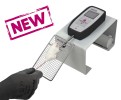Authors
B. Ling, N. Authier, D. Balayssac, A. Eschalier, F. Coudore.
Lab
Laboratoire de Pharmacologie-Toxicologie, CHU Gabriel-Montpied, Clermont-Ferrand, France.
Journal
Pain
Abstract
Acrylamide was intraperitoneally administered to male Sprague-Dawley rats at four different doses (5, 10, 20 and 30 mg/kg) three times a week for 5 consecutive weeks. Because of motor dysfunction, the 30 mg/kg dose was not used for behavioral pain tests. Clinical status remained good throughout the experiment and no motor deficit was observed at the other doses. We showed that acrylamide administration at low doses and cumulative dose (CD) range of 35–140 mg/kg produced mechanical allodynia and rapid, marked heat (42 °C) and cold (10 °C) allodynia after tail immersion test. Mechanical and thermal hyperalgesia appeared after higher cumulative doses (70–280 mg/kg), except for cold (4 °C) hyperalgesia (20–80 mg/kg). All the modifications persisted throughout all study, except the mechanical hyperalgia. All the cumulative doses tested were lower than those generally reported to induce motor dysfunction (CD>250 mg/kg), confirming that CD may be considered to be a suitable index in assessing neurological signs and suggesting that early detection of acrylamide neurotoxicity would be possible using the sensory tests, especially those for detecting allodynia thresholds.
BIOSEB Instruments Used:
Grip strength test (BIO-GS3)

 Douleur - Allodynie/Hyperalgésie Thermique
Douleur - Allodynie/Hyperalgésie Thermique Douleur - Spontanée - Déficit de Posture
Douleur - Spontanée - Déficit de Posture Douleur - Allodynie/Hyperalgésie Mécanique
Douleur - Allodynie/Hyperalgésie Mécanique Apprentissage/Mémoire - Attention - Addiction
Apprentissage/Mémoire - Attention - Addiction Physiologie & Recherche Respiratoire
Physiologie & Recherche Respiratoire
 Douleur
Douleur Système Nerveux Central (SNC)
Système Nerveux Central (SNC)  Neurodégénérescence
Neurodégénérescence Système sensoriel
Système sensoriel Système moteur
Système moteur Troubles de l'humeur
Troubles de l'humeur Autres pathologies
Autres pathologies Système musculaire
Système musculaire Articulations
Articulations Métabolisme
Métabolisme Thématiques transversales
Thématiques transversales SFN2024: Venez rencontrer notre équipe sur le stand 876 à Chicago
SFN2024: Venez rencontrer notre équipe sur le stand 876 à Chicago 